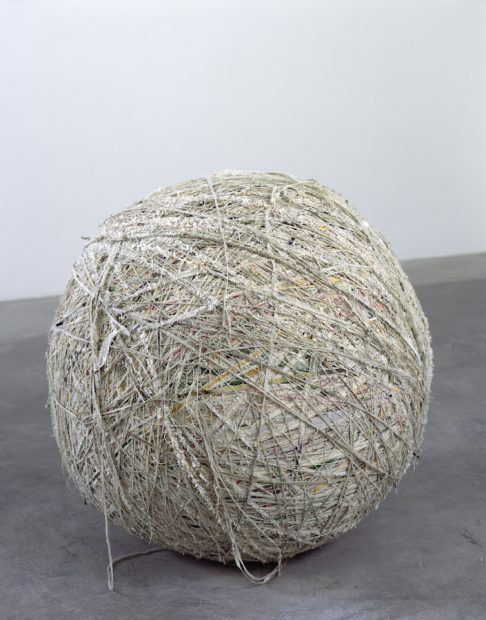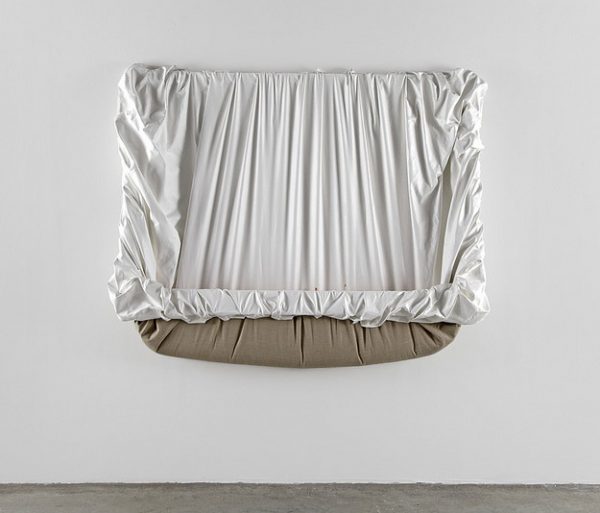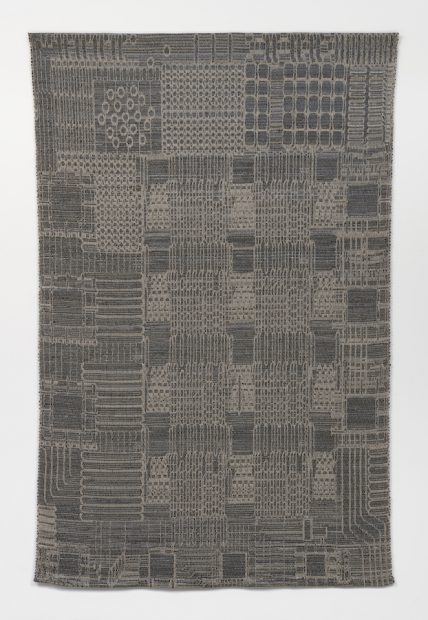
Analia Saban, Tapestry (Optical Mouse, Computer Chip for Motion Detection, Xerox, 1980), 2018. Woven acrylic paint and linen thread.
Overall: 102 × 66 3/4 × 3/8 in.
I spoke with the Los Angeles-based artist Analia Saban last week about her FOCUS exhibition at the Modern Art Museum of Fort Worth, which opened on March 30. The work, created in the past 12 months in anticipation of this show, explores a relationship between the analog and the digital, with an emphasis on materiality.
Christopher Blay: The first thing that strikes me about your work is the scale of it, and then the material. Looking at Tapestry (Optical Mouse, Computer Chip for Motion Detection, Xerox, 1980), I notice it has the same sort of visual weight as the mass-produced plastic placemats you find in markets and discount stores. It has a kind of shimmer, and you know it’s woven — but it’s woven acrylic paint.
Analia Saban: Yeah, I think I know what you’re referring to, and its true. That’s part of my research into the history of painting, because I am fascinated by the fact that acrylic paint is basically a plastic. So it’s interesting that you bring this up.
CB: The analog equivalent is unsophisticated, but your piece has the physical memory of it. But I want to talk about this idea: that you’re unraveling and deconstructing paintings, and almost using the materials as the source of where the information lies. It’s like programming — we can see the circuit board but we can’t see the information. It’s latent — like a photograph, like an undeveloped piece of film. What is your relationship to the visual information in a painting versus the latent contextual information?
AS: Yes, but what do you mean like an undeveloped photograph? I mean I do know what you mean, but where do you see that here [in this piece]?
CB: Sorry, not in this tapestry. But you lay out almost a chronology, from unraveling the canvas in paintings, to weaving the paint back in, to creating other objects. When I look at The Painting Ball, for example, I see that it’s a collection of paintings, but I can’t decipher it, even though the information is there. It’s like an undeveloped photograph. You know that once it’s placed in the developer it’s going to appear — and looking at the ‘blank’ photo paper in the darkroom, the information is there, but you can’t perceive the totality of the information.
AS: I see what you mean. Well, in the case of the painting ball, it’s very interesting because I’m trying to unravel painting, right, to try to understand how it’s made, or what’s inside in a way — just to ask those questions and see whether I can… . It’s almost like archeology; break it apart and dig to see if I can find any answers. I mean there is a lot in paintings that you don’t see, because it’s in the back of the canvas, or in the under layers and so on, so to break it open is trying to understand how it’s made. But then it’s true because in a way it’s almost like it doesn’t lead you anywhere [laughing]. You know, you can really go — but once you’re there it’s still hard to go deeper.
CB: At that point you can’t reduce it further, or if you do it becomes like a rabbit hole… .
AS: Exactly, but I have seen a lot of paintings through a microscope and I think that’s really fascinating, because that’s when you do see its pure archeology. You see the inner layers, you see the rocks that make up the pigment if they were made or ground by hand, and you still see if they added some fillers because the pigment was so expensive, and they maybe added some cornstarch or something just to extend it, and then you see the inner layers — but it’s a whole process, and I feel like there is a lot of information always hidden in the making, or the under layers. And I feel like it creates this myth around the work and I always try to open that up a little bit.
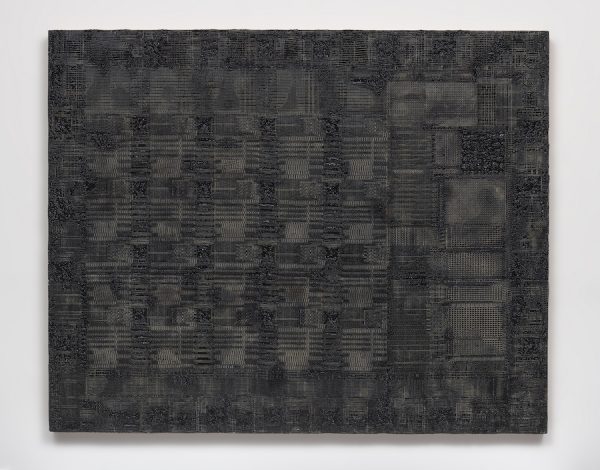
Analia Saban, Pleated Ink (Optical Mouse, Computer Chip for Motion Detection, Xerox, 1980), 2018. Ink and laser carved paper on wood panel.
Overall: 50 × 62 1/2 × 2 1/8 in.
CB: It’s the same mystery I see in the construction of your circuit board tapestries. They have information, but it’s a black box. We can’t see what the information is, although there is information present in the design. One of the things that I’m curious about is whether you’ve ever speculated about the ‘functionality’ of these tapestries.
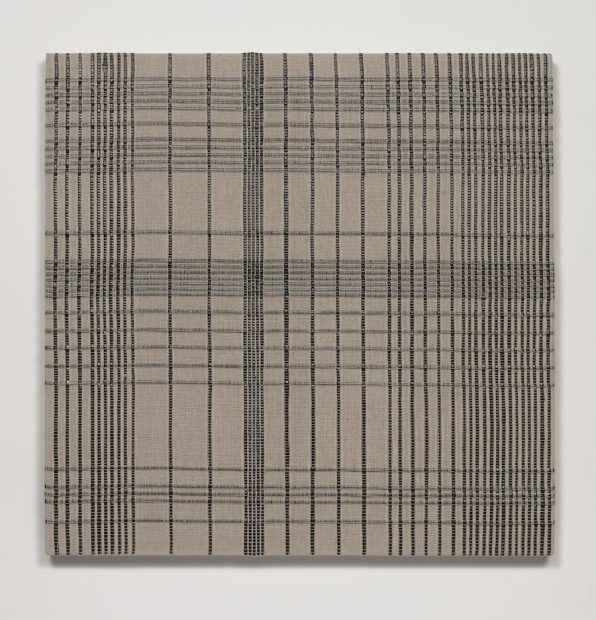
Analia Saban, Plaid, 2018. Woven acrylic paint and linen thread. Overall: 39 1/4 × 39 3/4 × 2 1/8 in.
AS: Yeah, I’ve been doing a lot of research on circuit boards. In a way that was a big force for the project because they are so present in our lives, but we don’t look at them because they are inside a box. So one of the circuit boards that is very prominent in this show was for the first optical mouse, which is Pleated Ink (Optical Mouse, Computer Chip for Motion Detection, Xerox, 1980), and it’s translated to the same piece in tapestry form [Tapestry (Optical Mouse, Computer Chip for Motion Detection, Xerox, 1980)]. And because I wanted to make those connections between textile and fabric, I cut a little section and that became Plaid (2018) because I feel that it’s important to have that connection between abstraction and representation, even though it’s quite abstract, you know — the first optical mouse — but it’s a very functional object that is used on a daily basis, and also the first circuit board. And this [Copper Tapestry (Dallas Semiconductor, DS 1000z, 1991] was a huge development for the history of conductivity, and how important that was to [solve] more complex problems. This is not the first, but the most advanced semiconductor [at the time], and I was very fascinated to know that most of the history of the semiconductor happened here in the area, in Dallas.
Analia Saban, Copper Tapestry (Dallas Semiconductor, DS1000Z, 1991), 2019. Woven copper wire and linen thread.
Overall: 86 3/4 × 65 1/2 × 1/16 in.
CB: So the other kind of functionality I was thinking about was this: Copper Tapestry is an exact replica of the semiconductor, although maybe the resistors or other components are absent — but I wonder if you’ve ever considered the implications of a tapestry that functions as a semiconductor?
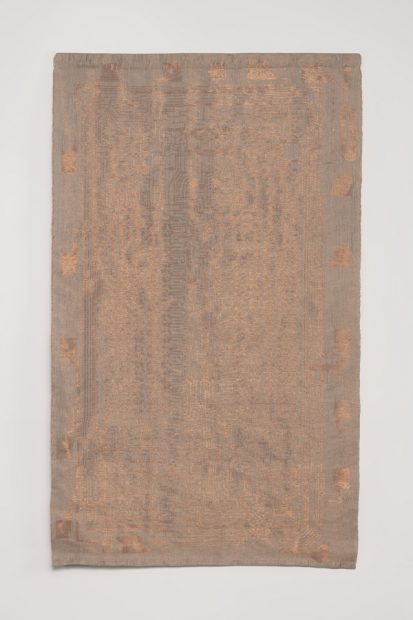
Analia Saban, Copper Tapestry (Intel 4001 Mask Programmable ROM, 1971), 2019. Woven copper wire and linen thread. Overall: 59 1/2 × 35 3/4 × 1/16 in.
AS: Oh, I think you could. Of course this is more of a poetic gesture, but the fact that it’s now woven with copper: in theory it’s all connected, and in theory it could have some functionality. Let’s say if you had, I don’t know, some sensor at one corner, and a light bulb at another. I mean, in theory, the light should come on. But I don’t think I want to try it, and set it on fire or something [laughing]. But the intention was that it was a gesture that the copper was conducting energy through the whole piece.
CB: Back to a canvas piece: Woven Grid as Warp and Weft. What can you tell me about it? If I remember correctly from your lecture, it’s a canvas you created with a loom.
AS: It’s acrylic paint woven at the same time as the canvas. The idea was to change the order of things, because usually we tend to paint on canvas. So I thought it’d be interesting to weave the paint through the canvas.
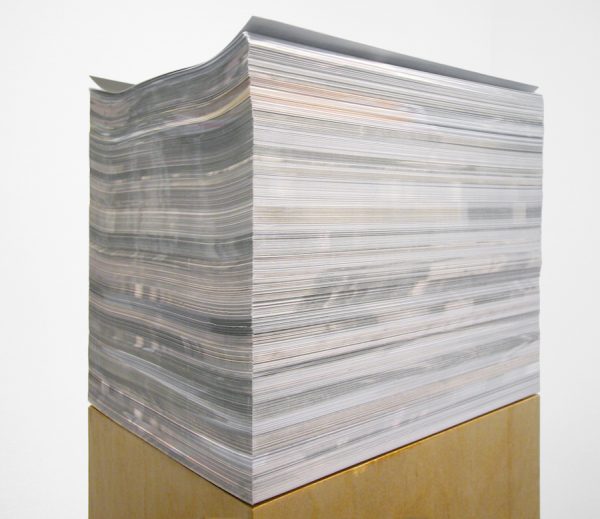
Analia Saban, 30 Second Commercial, 2004. 900 archival digital prints on pedestal. 8.5 x 11 x 5.5 ft.
CB: You did that with the paper pieces as well. You’re putting paper on ink, instead of the other way around. So one of the things that I understand from your process is that this ink takes six to nine months to dry, which is kind of a gestation-period equivalent, if you think about it. That connection is interesting; even though this material is ‘synthetic,’ it has a lot of organic (or lifelike) qualities.
AS: Yes — so this is actually petroleum-based, oil-based, organic ink; that’s why it takes all this time to dry. The process of drying is more related to oxidation than [it is for] acrylic paint, which is water-based (once the water dries out the paint is dry). So it’s a very organic material that reacts to the paper and makes all the patterns visible here [in Pleated Ink]. The paint slowly starts drying and contracting, depending on the paper that it interacts with. I thought it was an interesting kind of conversation between a very organic material and this layer of paper that is very precisely cut.
CB: One of the relationships I find interesting is that you’re removing materials from early works, and here you are combining materials… . Are you dissecting and removing material as a way of talking about the absence of things, or are you filling voids when you compose paintings by weaving materials in?
AS: I would say it’s more an addition — to have that conversation between these two very different materials. It’s a nice question, actually. I mean, I think it has to do more with removing something and then replacing it with something else, [to] see that tension, to see what happens.
CB: It reminds me of what you say about the line between representation and abstraction, or the analog versus the digital.
AS: Yes, because the ink would be very analog and the paper cutout would be very computer-oriented, very digital.
CB: I’d like to ask you about a work from 2012 that’s not in this show [though it was in a solo show at University of Houston’s Blaffer Gallery in 2016-17]. In Trough (Flesh), you pour the equivalence of your body weight into an oversized canvas, stretched over a stretcher measuring the height of your body. I see it as a self-portrait. What interested you in making that painting?
AS: I always felt that paint has this connection to the body. I come from Argentina, and this is an interesting story: Our White House, our government house, is actually pink, and it’s because Argentina’s main economy is cows, and they export meat all over the world. This was from very early days. So the first time they painted the building, they painted it with blood and plaster. And I thought that was so interesting — the fact that blood was the source of the pigment.
And looking at the history of pigments, there are so many organic materials. People were taking pee from cows to make yellow, they were using eggs, and pigments from plants — a lot of organic materials. So I feel like there is this pleasure in painting, but also this connection… that we are bags of paint in a way. We are wet, just like a painting, and the color is quite intense and beautiful, and I wanted to emphasize that.
One of the pleasures in painting is you work with the material when it’s wet and then it dries out. And people do talk about the painting being dead — in that it is done — and I felt that there was this connection to the body. We obsess about aging when it comes to a painting, and we deal with very similar issues ourselves.
CB: Sure, archival preservation and… .
AS: Yes, you want to preserve your body, and you want to preserve a painting, and I feel like painting in particular has more of those issues that we share, than, let’s say, a piece of marble that might stay the same for more years, or a piece of bronze. So I wanted to emphasize that connection.
CB: The very deconstructed way you deal with paintings [in your work] — does that affect the way you see paintings now?
AS: It does. I mean, it always did, I have to say — even when I started going to museums in my teenage years. I [would] always look at the light hitting the paintings and how it makes a reflection on the surface, and that gives you a completely different understanding of the painting. You see the brushstrokes, the highs and the lows of the paintings, so I was always kind of looking at paintings like this (tilts her head to look from the bottom of the tapestry) to see the reflection, so you can see how in a way this translates into [how I look at paintings differently]. This painting in particular (Pleated Ink) looks like looking at an ink drawing under a microscope — but you know, seeing all those different imperfections enlarged. I want to also look at the edge of a painting, look around it, almost treating the painting as a whole object, as a sculpture as opposed to a two-dimensional piece.
CB: This reminds me of the suspicion that I have: that most painters become sculptors. There must be something about two-dimensional surface not being sufficient. I see this in your work as it jumps off the 2D surface and it comes back, but it has a different relationship to painting.
AS: I have to say there is so much pleasure in painting. I mean, I understand why people paint, why children paint — it is moving color around the paper, moving a substance around the paper. To me there was never a distinction between the two [painting and sculpture]. I mean I always felt that a painting was a sculpture, but I can see the impulse to build on that because there is such a pleasure in dealing with colorful substances.
CB: And you’re still doing that — your understanding of painting as the physicality of paint being applied to a base, for example. You’re taping it on, stripping it, and adding to surfaces, like in Portrait Tone Acrylic and Linen Color Thread on Linen.
AS: Also, showing this work here, in the context of this architecture, it is hard to imagine a better place. [Tadao] Ando is so interested in materials at such a basic level: the surface of the concrete, the surface of the wood, and the light. I wanted to make works that would have that conversation with the architecture, using very basic materials like linen, paint, and very little color — kind of letting the materials be themselves.
On view at the Modern art Museum of Fort Worth through May 12, 2019.
This conversations has been edited lightly for length and clarity.


